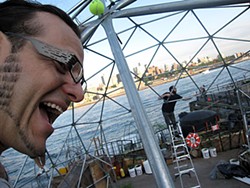[
{
"name": "Top Stories Video Pair",
"insertPoint": "7",
"component": "17087298",
"parentWrapperClass": "fdn-ads-inline-content-block",
"requiredCountToDisplay": "1"
}
]
It's not your typical barge. The Waterpod, a floating art project currently plying the waters surrounding the island of Manhattan, is outfitted as be-domed "sustainable, navigable living space." Launched last week from the Brooklyn Navy Yard, where initial construction took place, the barge/pod is currently docked at South Street Seaport. The pod's inhabitants, a group of New York artists, plan to spend the summer living aboard as it moves from dock to dock along Hudson and East River shores.
They'll be growing food using a hydroponic system housed in a geodesic dome greenhouse, performing music and showing art in a larger dome where power comes from batteries charged by a solar array and bicycle power, and showing off alternative technology in general.
In many ways it sounds like something you'd find in eco-groovy Humboldt County -- and it is. Students from an engineering class at Humboldt State University designed many of the Waterpod's sustainable living systems. Their instructor, Lonny Grafman, who also serves as faculty advisor for CCAT, HSU's Campus Center for Appropriate Technology, is in New York helping to fine-tune various systems.
"It's like Humboldt has invaded the New York waterways," said Grafman. "Of course, CCAT was a large influence. They're a leader in student-run sustainability organizations."
Mary Mattingly, a sculptor/photographer from Queens, is chief visionary behind the project. She sees the Waterpod as "a composition, a transport, an island, and a residence ... a realistic alternative to traditional living spaces" -- one designed with climate change and the rising tides in mind.
"I'm concerned about what the future is going to be like," said Mattingly, calling by cell phone from the barge. "In a country like America we have a different relationship with looking at the future than countries that are already dealing with climate change."
So how did HSU engineering department students end up involved in this art project/experiment in sustainable, autonomous living? The connection with Mattingly came through a website and organization Grafman founded called Appropedia (www.appropedia.org), which serves as an open source wiki/clearing house for use of appropriate technology in sustainability, poverty reduction and international development.
For Grafman, the Waterpod was a natural. "It's a project designed to engage and inspire communities in sustainability and the issues of climate change," she said.
It's also a platform where others can see first-hand some of the alternative tech Humboldters have been working on for years. "When people look at the technology they're like, 'What, a bicycle that's powering a blender?'" said Grafman. "A composting toilet is another mystery. For people in Arcata some of this might seem almost pedestrian -- here it's completely alien."
The project seemed a perfect fit for his class, Engineering 215: Introduction to Design, where "students work in teams with a client to address some real-world problem or opportunity." Previously the E-215 class has outfitted the Discovery Museum in Eureka with renewable energy systems designed for kids to play with while they learn. The class also produced design models for the Humboldt Bay Center for Sustainable Living eco-hostel project.
In this case the "problem" was dealing with the Waterpod's assorted engineering needs, said Grafman. "[Mary and I] worked together to come up with a list: 'We need electrical energy. We have access to sun, access to wind, to water, to human power.' We parsed those into individual chunks. And there were others: 'We have human waste to deal with. We have food waste to deal with. We want chickens onboard.' The students get these broad problem statements and work tackling real problems, and the client is able to help students learn while receiving tangible benefits."
Grafman figures the process exemplifies the effectiveness of service learning. "The students were able to learn the engineering design process with a real client, and the barge has been capturing the imaginations of the visitors, from the incredulous to the inspired, in part due to the students' creations."
Locally designed components of the Waterpod include a classic CCAT pedal-powered electric generator called the Human Energy Converter (H.E.C.). There's also a hydroponic system growing herbs for the kitchen, a dry composting toilet (akin to an outhouse) and a high-tech filtered rainwater catchment system (like an old-fashioned cistern, but safer) with a hydropower system capturing energy from the overflow. A high-tech chicken coop designed by a team of students was adapted by a New York artist utilizing a repurposed shipping crate.
"An impressive part of the barge is the graywater system, an on-barge subsurface graywater marsh designed by Tressie Word that I'm pretty sure is the first of its kind," said Grafman. "It's like a micro-version of the Arcata Marsh on a moving surface -- the barge tips and rolls back and forth. It's just for graywater, not for fecal material."
It goes without saying that the Waterpod is outfitted with solar panels, although the HSU students did not design them. And, Grafman pointed out, the kitchen includes a made-in-Arcata Sun Frost refrigerator and a Sun Frost Scrap Eater, "a stylish, high-tech composter."
For Mattingly, "The Waterpod is like looking at the present and making a living sculpture that we can use as a test space to gather information about current technologies, and about how technologies hundreds of years old are as valid, if not more valid, than what we're using today."
more from the author
-
Around Humboldt County
- Sep 3, 2014
-
Around Humboldt County
- Aug 27, 2014
-
Around Humboldt County
- Aug 20, 2014
- More »
Latest in News
Readers also liked…
-
Through Mark Larson's Lens
A local photographer's favorite images of 2022 in Humboldt
- Jan 5, 2023
-
'To Celebrate Our Sovereignty'
Yurok Tribe to host gathering honoring 'ultimate river warrior' on the anniversary of the U.S. Supreme Court ruling that changed everything
- Jun 8, 2023

































